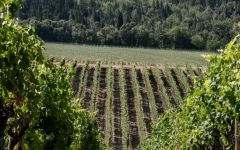Isole e Olena Chianti Classico 2017
-
James
Suckling - Decanter
-
Wilfred
Wong



Product Details
Your Rating
Somm Note
Winemaker Notes
Estate-grown, hand-harvested grapes are fermented in temperature-controlled stainless steel tanks with approximately 15 days maceration. During fermentation, delestage and pumping-over takes place twice a day. After the malolactic fermentation, the wine is racked into barrels and 4,000 liter casks where it matures for about one year.
Professional Ratings
-
James Suckling
A very pretty 2017 Chianti Classico with a beautiful core of ripe fruit and layers of round, lightly chewy tannins. Dark cherries, walnuts and chocolate.
-
Decanter
It is strange to see a bright red wine, and to smell ripe pinky-yellow peach. But I am told that peach is not such an unusual note for the Sangiovese from this hillcrest, along which the great estates Isole e Olena, Paneretta and Monsanto sit, looking out towards the Tyrrhenian sea. Winemaker Paolo de Marchi is a great fan of the native Canaiolo Nero and blends in 15%, contributing a black/violet colour, breadth, softness and spice to balance the austerity of Sangiovese. A consistently excellent wine. Drinking Window 2021 - 2030
-
Wilfred Wong of Wine.com
COMMENTARY: The 2017 Isole e Olena Chianti Classico is fresh, bright, and pleasing. TASTING NOTES: This wine exhibits lovely ripe red and black fruit in its aromas and flavors. Enjoy it roast chicken over pasta. (Tasted: July 6, 2020, San Francisco, CA)
Other Vintages
2020-
James
Suckling - Decanter
-
Robert
Parker
-
Wine
Enthusiast -
James
Suckling -
Robert
Parker
-
James
Suckling -
Robert
Parker
-
Wine
Spectator -
James
Suckling - Decanter
-
Robert
Parker
-
Wine
Enthusiast -
James
Suckling -
Wine
Spectator - Decanter
-
Wine
Enthusiast -
James
Suckling -
Robert
Parker
-
Wine
Enthusiast -
James
Suckling
-
Wine
Enthusiast - Decanter
-
Robert
Parker
-
Robert
Parker
-
Robert
Parker
-
Wine &
Spirits





Founded in 1956 by Francesco De Marchi, this historic Chianti Classico estate is located in the western part of the denomination, near Castellina in Chianti, in the commune of Barberina Val d’Elsa. Isole e Olena’s 56 hectares (138 acres) of vineyards sit at 350-450 meters (1,148 – 1,476 feet) above sea level on soils of galestro and marly schist.
In 1975, Francesco’s son, Paolo De Marchi, ushered in a new era at Isole e Olena by taking over the estate. With his background in agricultural studies, Paolo started to revolutionize the winery beginning in the vineyards. He began experiments with the clear goal of enhancing the quality of the region, improving the performance of the local grape varieties (mainly Sangiovese) through massal selection, and mapping his galestro-driven soils. Thanks to the philosophy of Paolo De Marchi, Isole e Olena is considered among the pioneer estates who led the quality renaissance of Chianti Classico starting in the 1970s and becoming a reference for the area.
1980 saw the first bottling of Cepparello, a pure Sangiovese from old vines, aged in barrique, which in time has become an emblem of Isole e Olena. First classified as “vino da tavola” (table wine) it went on to become one of the first Supertuscan wines, showing the character and longevity of Sangiovese from this high-altitude corner of Chianti Classico. Cepparello is the result of Paolo’s extensive study of the Sangiovese grape and his belief in the potential of its expression.
Today Isole e Olena is recognized for the leading role it played in the emergence of the Chianti Classico region and respected for its authentic style of Chianti Classico – fragrant and well-balanced with purity of fruit – which is representative of its high-altitude territory. In addition to Chianti Classico and Cepparello, Isole e Olena also produces a series of single varietal wines: Chardonnay, Syrah, and Cabernet Sauvignon, as well as an acclaimed Vin Santo.

Among Italy's elite red grape varieties, Sangiovese has the perfect intersection of bright red fruit and savory earthiness and is responsible for the best red wines of Tuscany. While it is best known as the chief component of Chianti, it is also the main grape in Vino Nobile di Montepulciano and reaches the height of its power and intensity in the complex, long-lived Brunello di Montalcino. Somm Secret—Sangiovese doubles under the alias, Nielluccio, on the French island of Corsica where it produces distinctly floral and refreshing reds and rosés.

One of the first wine regions anywhere to be officially recognized and delimited, Chianti Classico is today what was originally defined simply as Chianti. Already identified by the early 18th century as a superior zone, the official name of Chianti was proclaimed upon the area surrounding the townships of Castellina, Radda and Gaiole, just north of Siena, by Cosimo III, Grand Duke of Tuscany in an official decree in 1716.
However, by the 1930s the Italian government had appended this historic zone with additonal land in order to capitalize on the Chianti name. It wasn’t until 1996 that Chianti Classico became autonomous once again when the government granted a separate DOCG (Denominazione di Origine Controllata e Garantita) to its borders. Ever since, Chianti Classico considers itself no longer a subzone of Chianti.
Many Classicos are today made of 100% Sangiovese but can include up to 20% of other approved varieties grown within the Classico borders. The best Classicos will have a bright acidity, supple tannins and be full-bodied with plenty of ripe fruit (plums, black cherry, blackberry). Also common among the best Classicos are expressive notes of cedar, dried herbs, fennel, balsamic or tobacco.
